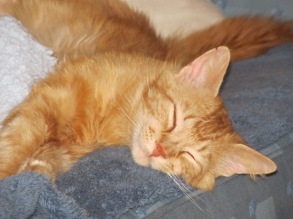A few weeks ago, I noticed a proliferation of pink flowers popping up in gardens and yards all over town. On tall, leafless green stems, they stood like grand bouquets that had left the tidy security of their vases to lift themselves up to the sun and rejoice in the last days of summer.
I had never seen these beauties before, and no one I asked was sure of their identity, so naturally I turned to Google. (As a card-carrying bibliophile and budding botany enthusiast, I am quite frankly almost ashamed to admit that I don’t have a shelf full of floral reference books, but there you have it.) I entered a search for “pink flowers on long stems.” Within seconds, I had my answer: the mystery flowers were Amaryllis Belladonna, or Belladonna Lilies!
Seeking more information about the flower, I learned that it is not a “true” lily; rather, it’s the only true amaryllis, the only species in its genus, and it goes by many names. The Amaryllis is related to the very large Liliacea family but does not have the same toxic properties – and this is very important to those of you who share your homes with cats – as the more common “true” lilies (for example, Easter, Asiatic, Day, Japanese show, etc. – these lily varieties are extremely poisonous and potentially fatal to cats and should never be displayed or grown in a feline household.) The popular indoor Christmas plant that you probably know as an Amaryllis is properly called Hippeastrum. (Are you confused yet?) Across the pond in ye olde England, the Amaryllis Belladonna is often called the Jersey Lily, thanks to a celebrated painting of the wildly popular English actress Lillie Langtry (1852-1929,) who came from the Isle of Jersey, holding the flower. (Apparently, she was actually holding a pink Guernsey Lily, which is not the same thing at all, but the name stuck!) Finally, many gardeners refer to these flowers as ‘Naked Ladies’ because the summer blooms perch on leafless, or naked, stems.
Regarding the toxicity of the Amaryllis Belladonna, it’s important to note that the leaves, stems and bulbs contain phenanthridine alkaloids which can cause vomiting, hypotension and respiratory depression in both cats and dogs. Excess drooling or salivation, as well as abdominal discomfort, can result from the raphide oxalate crystals; these are more concentrated in the most poisonous part of the plant, the bulbs. If your cat or dog consumes a large amount of the plant’s toxins, the animal may experience convulsions, low blood pressure, tremors and cardiac arrhythmia. If you think your pet has eaten any part of this lovely plant, please call your veterinarian or a pet poisoning hotline immediately! (A great resource is www.petpoisonhelpline.com, but in an emergency situation you should CALL the helpline or your vet – don’t waste time trying to search for the information yourself!)
One last fun fact that I’ve learned about the Amaryllis Belladonna: when properly cared for, an amaryllis bulb can produce flowers for up to 75 years! I’m afraid that the poor soil in our current home garden will not support these beauties, even if they are “easy growers,” but I’m very glad that the South African native made its way around the world many years ago so that I’m at least able to enjoy it simply by taking a drive around town, or by paying a visit to our local botanical garden. I shall look forward to seeing it again next year!





